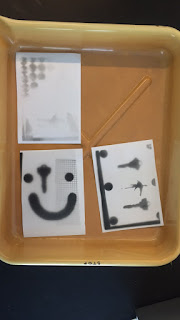These are my Print 1 Pictures starting with my test strips and ending with my final big picture.
1. First you have to take the pictures using the camera provided.
2. Next you take the film out in the developing bag and then you put the roll of film through the chemicals.
3. Once you leave the film to dry, you pick five pictures and you make a test strip with the five pictures on the film. You do two seconds using the cardboard and your filter is on F8. Put through chemicals when done.
4. Then you pick the picture that is the most clear and has black white and grey and you make another test strip using 2 seconds with the cardboard and using the filter F8. Put through chemicals. You then analyze how many seconds shows the black white and grey and you do it for that many seconds on the big piece of paper.
5. Once you put it through the chemicals, your picture should have black white and grey, it should be clear, all edges should be even, and there shouldn't be any agitation marks on it. You then make once more big picture so you have two.
6. Finally, post your hard work on blogger staring with your test strips all the way to the finished product.















